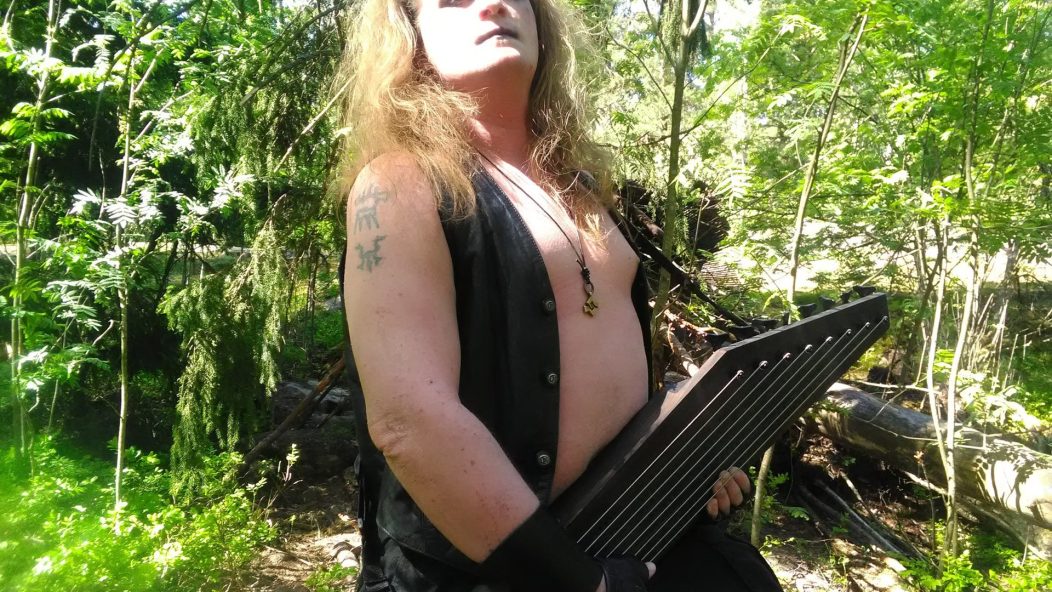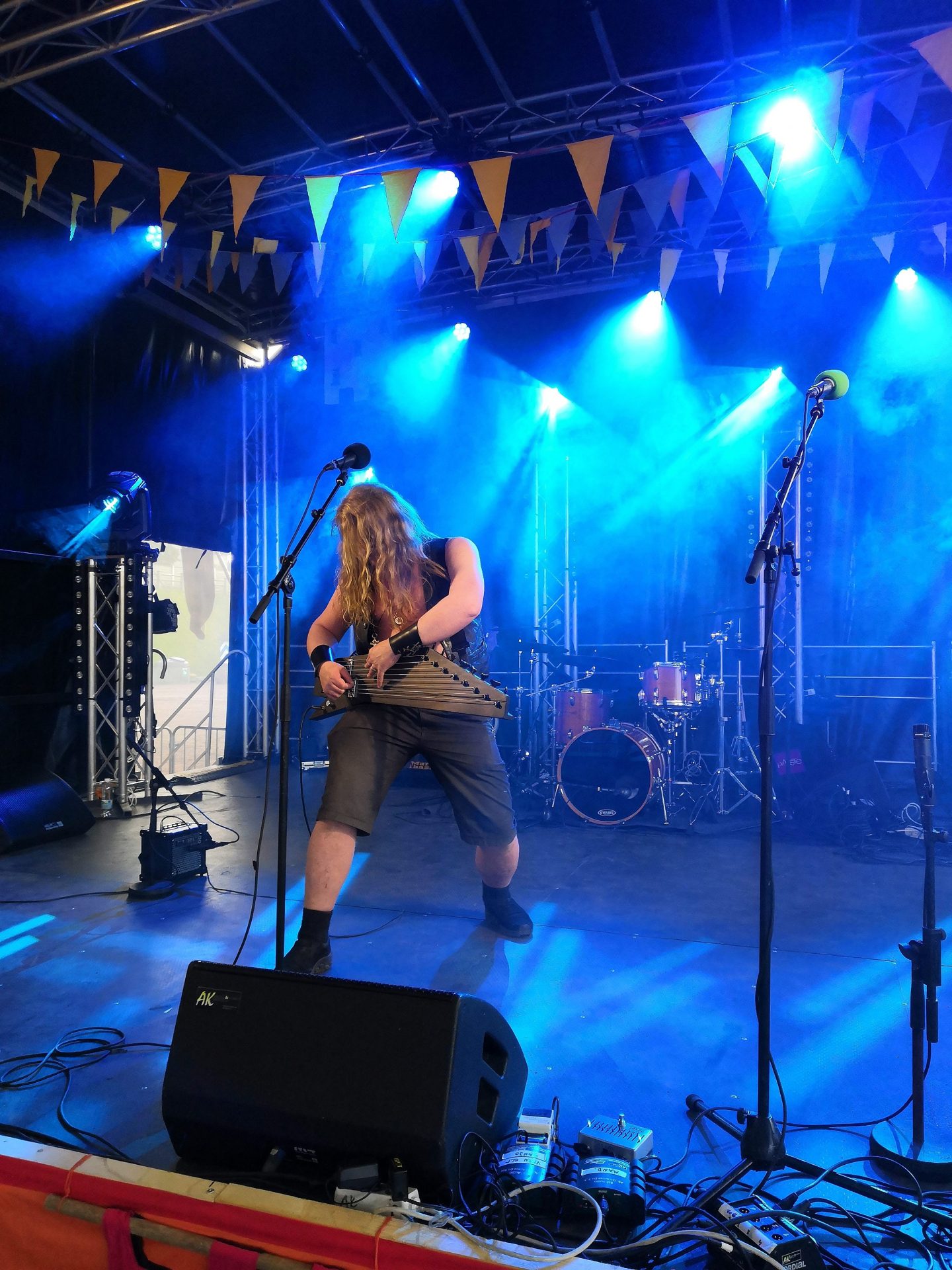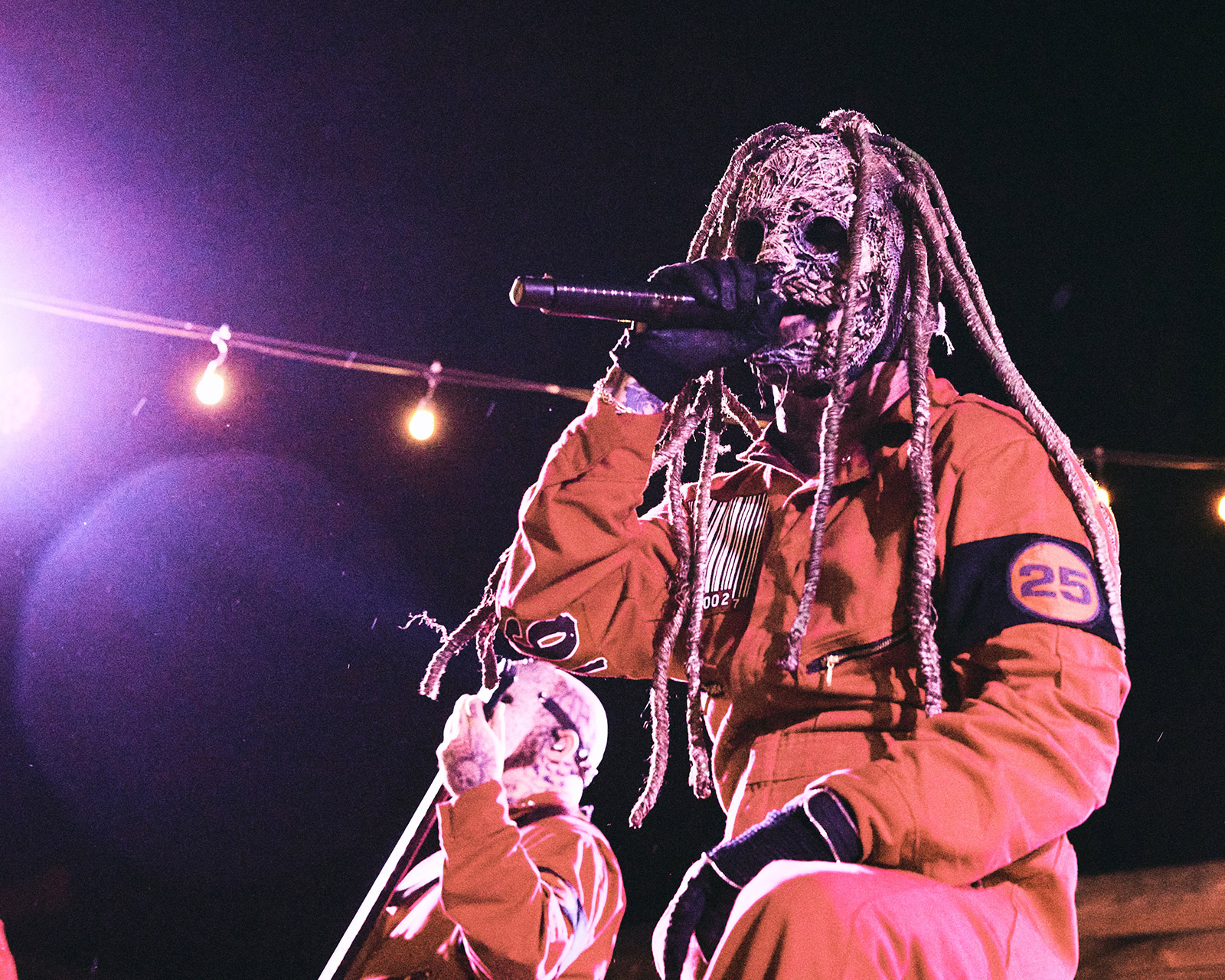
Juha Jyrkäs: Folk Metal Master (Interview)
Metal has a penchant for looking backwards for influence, be it the metal and rock which preceded it, or even as far as Romantic and Classical musics, but some artists like Finland’s Juha Jyrkäs look much, much further. Fusing traditional Finnish folk music and instrumentation with metal and psychedelic rock, Jyrkäs’ hypnotic, enchanting music elicits mental images of vast silver birch forests and people singing around campfires, albeit distorted and tangentially aggressive. On his latest album, Sydämeni kuusipuulle (“My Heart is for the Spruce Tree”), Jyrkäs’ use of the kantele, Finland’s national instrument (a five-plus-string zither which is tuned both diatonically [within an eight-note scale] and pentatonically [within a five-note scale], depending on how many strings the instrument has), in place of guitars and bass crafts a uniquely ancient, droning atmosphere, and atmosphere is the key element to his music, here.
A fixture in the Finnish folk metal community, Jyrkäs considers himself a loner, though he has collaborated with the likes of Korpiklaani, Auringon Hauta, and more. These collaborations, while important musically, don’t seem to faze Jyrkäs, who is much more concerned with his own experiments. A mad scientist of folk metal and neofolk alike, Juha Jyrkäs, through his various works as Poropetra, Tevana3, and under his own name alike, recontextualizes ancient song types and brings them into a new age. In a new interview which can be read below, Jyrkäs reflects on his career as a folk and metal musician.
…
…
When did you first start playing the kantele?
It was spring 2002. I was jamming with my friends and there was a 5-string kantele. I picked that up and started to play. I was fascinated with the folk metal movement at that time. Moonsorrow’s album Suden uni, Finntroll’s two first albums and Shaman’s (pre-Korpiklaani) first two albums were the major influence to me at that time. I wanted to make similar music. Kantele was quite an easy instrument to start with. I learned quickly some basics out of it and then I had the ability to make my own music with it.
Can you describe the kantele’s cultural significance to Finland?
Kantele is called “the national instrument of Finland.” I understand it, since it is very Finnish and has a connection with Finnish culture. But at the same time it’s not the whole truth. Kantele is also a folk instrument for other Balto-Finnic peoples like Estonians, Karelians, Baltic peoples like Latvians and Lithuanians, and even with Russians who live in Northwest Russia. It has many names: kantele in Finnish, kannel in Estonia, kokle in Latvian, kankles in Lithuanian and gusli in Russian. And, to be fair, there are similar types of zither-instruments all over the world. So all in all kantele is very Finnish but it’s also a very international instrument, also.
We have kantele competitions, kantele unions etc. here in Finland. Kantele is a known instrument, but at the same time calling it as a national instrument is a burden. People see it as “Väinämöinen’s instrument.” Väinämöinen is a demigod and a powerful shaman in Finnish mythology, thus the kantele playing in Finland is stuck. It is nice, clean, and all the old folk tunes and songs are played all over. But that’s it. The tradition does not evolve. Of course, there are artists who have, for example, played pop songs with kantele, but it’s all done with very smooth, clean and with very non-interesting way that’s not popping up. Tradition must be upkept, for sure, but it also has to be renewed and reinvented and evolve forward. And this is a big problem in Finland: no-one really rocks with kantele–except me, heh!
When did you first decide to fuse the kantele and metal?
The first time I tested electrified kantele-effects was already at 2007 with my previous band, Poropetra, in our only album Sinihirwi with few songs. But it was more about making some good soundscape to the songs. The moment I really wanted to make a kantele fulltime metal instrument, came up purely with the conclusion of many things. In 2007 I was fed up with everything folk-related and I wanted to make some metal! First I tried to learn myself to play bass, in order to build the regular ordinary metal band. But it was too slow. I realized that it would take too much time to reach the same level as I was with kantele. I was frustrated. Then one day I gave myself a thought: if my skills won’t advance, then the instrument has to change. I ordered to myself my first electric kantele, amplifiers and effect pedals. The first time I plugged my kantele in with full distortion, it was a “blow.” I realized this is something new. It was time to reinvent myself and my music. I found the band Tevana3. We made the first metal album in the world in which all guitars were replaced with electric kantele.
…

…
Did you run into any difficulties when discovering this “kantele metal” approach?
I have to admit that it has been hard to promote and market my music. It’s too unique. Maybe it’s too much ahead of its time. There are many people here in Finland that don’t get it. They can’t understand that you can do stuff like this with kantele. This is what I meant that kantele tradition is kinda stuck here in Finland. But in Estonia it’s a different story. As I was there doing a gig back in 2016, the whole audience went wild! And in every corner of the world there has been an interest in my music. Time will tell how my pioneer story with kantele metal will end.
You’ve lent your “voice” to bands the likes of Korpiklaani and Auringon Hauta. How do you feel throat singing and folk metal interact? Did you find the fusion to be easy or difficult?
In the past I have been visiting into the songs of those bands where my friends play. I’ve written lyrics for Korpiklaani during 2006-2012, I have played kantele with Korpiklaani and Auringon Hauta and doing some singing with Auringon Hauta. I’ll visit if I’m asked to.
You are essentially an overlapping point in the Finnish “new folk” and metal scenes, tying together bands as disparate as Nest, Häive, Korpiklaani, and more. Do you see yourself as a central figure in the Finnish folk-inspired underground?
Mostly I see myself kinda loner. I do my own stuff. Pagan heavy metal with electric and bass kantele. Sure I will assist with the music, and this is how Nest, Häive, Korpiklaani, and so on come together via me, but mostly the circle inside Finnish musicians is very small. We kinda know each other very well, so this cooperation is a very natural thing, at least for me. Projects like Poropetra looked deep into traditional Finnish music, but present it in a more modern way. What is it like translating these old styles into something which can be digested by a new audience?
Finnish folk music is definitely one part of me that will always be in my music. But there’s other music too. I’ll wrap them all together. It’s my natural way to make music.
With my previous bands Poropetra was more blending together Finnish folk, world music and heavy rock, and Tevana3 fused together ethnic ambient, extreme metal and even punk! With my solo album Sydämeni kuusipuulle you can hear my musical history. There’s Finnish folk, 1980s heavy metal, black metal, folk metal and even some blues! In the future I’ll make my music as it comes. If it’s heavy, it’ll be heavy. If I want to create more beautiful soundscapes, I can do that, too.
What do you look to accomplish now that you’re creating music under your own name instead of a “project name?”
My solo career will be the thing for me in the future. My whole effort and creation will be put into it. I have so many things and so many songs I wish to do in the future. Within my solo career I’m free to explore myself and do whatever I want with my music, with no limits. I’ll definitely make it very wide how aggressive and how versatile metal with electric and bass kantele can become!
Do you ascribe to the personal traditionalism which often comes with playing traditional music?
The way I see it, I’m a part of the big continuum. I preserve something old, but then again, I create something totally new out of it.
You often bring various world music influences to the table when playing Finnish folk inspired music, which is surprising given how insular Finnish folk music traditions are. How do you view isolated, culture-based music and do you try to break free from those bonds?
The world music influences were one influence in my old band Poropetra, but in my solo project it’s more like combining many music elements. Like metal, rock, kantele music etc. I don’t ever consider what I do. I just do. I’ll play and think about what the songs want to tell me. The feeling, atmosphere of the lyrics and everything will determine if it’ll come more like black metal or more like folk.
What is it like combining the traditionalism of Finnish folk music with the freedom of a more experimental take on metal?
I just play what comes into my mind. I don’t think it is metal or is it folk. The songs just come as they are. My music comes from so many different directions it’s hard to separate them. They mix together naturally in my head and while I’m playing.
On your latest album, there is a pretty strict balance between the folk elements and the metal elements, even though both exist simultaneously within your musical execution. What was achieving this balance like?
I made every song in my debut solo album Sydämeni kuusipuulle in a certain way. I listened to the song itself. What it needed, how I could capture the best of the feeling. And thus the songs started to live their own lives. You can hear the versatility of it, like in “Korpien kutsu” there is some black metal, in “Tulisydän” you can hear power metal, in “Nuole mua” there’s some 80’s heavy metal, in “Voimaa” folk metal and in “Hämärästä aamunkoihin” even some blues vibes!
And since the lyrics are important to me, they define very much how the final song should sound. I’ve gone through depression and many bad things in life. I wrote many of these lyrics to ease my own pain and so some of the songs became gloomy too. And also the opposite, some songs have empowerment, joy and some badass rock attitude! They are also the other side of the coin.
There are what could be considered metal-style harsh vocals found Sydämeni kuusipuulle, but this isn’t too far off from yoik vocals and throat singing. Do you feel metal and Finnish folk music are connected beyond your fusion of the two?
My singing style is simply: it comes as it comes. I don’t think about it specifically. In Sydämeni kuusipuulle album I use harsh vocals, whispering, and clean vocals. They fit the best in the songs.
In the end, all the music is the same. It all derives from campfire chanting and singing. Later on, humans have just created different kinds of ways to bring that all out with various instruments.
Why do you think your fusion of genres works out so well? What kind of work went into making this happen?
I think this is easy for me, since it’s natural. All genres blend into my head into my own music, into my own style.
There is a psychedelic element to your newest album which can be traced back to your old band Tevana3, whose other members make appearances either behind the recording desk (Aslak Tolonen and Janne [formerly Varjosielu] Väätäinen). Do you feel your approach to folk/metal fusion is inherently psychedelic, or do you strive to make psychedelically textured music?
Psychedelic rock is one of the main influences I have. It comes naturally to the songs that are suitable for it. And of course, you can create awesome soundscapes with electric and bass kantele! I did had studio help from Aslak Tolonen and Janne Väätäinen. Janne helped me to
record the bass kantele and Aslak helped me to record the rest. They’re nice guys to work with.
…
…
Along with making folkish metal, there is what could be considered “metallic folk” which makes up the second half of your music’s identity. What made you want to make heavier folk music?
All in all, I do consider my solo album Sydämeni kuusipuulle under the flag of metal music, although no electric guitars, bass, keyboards or drums used on my solo album. It is still metal, since the soundscapes are so heavy. There are many occasions in Finland that I’ve been compared with Apocalyptica, who play metal with cellos. The idea is the same: I want to expand the boundaries of metal music. But doing so I break through the borders of kantele music, too. I’ve described my music at the term pagan heavy metal with electric and bass kantele. In my opinion no one shouldn’t limit themselves or stick with anything that’s categorized. People should always think outside of the box.
At this point in your career, where do you think you can take your style next?
Currently I’m writing some new music. At this point I only have some ideas and some lyrics. I will explore my limits where I can go after this. I have in my mind to make some more epic and even more versatile. To expand my musical universe even more. Basically I just have to reinvent myself after every album.
…
Follow Juha on Bandcamp.
…










